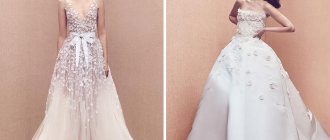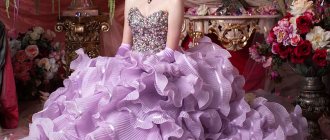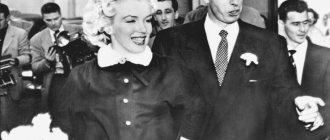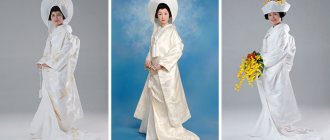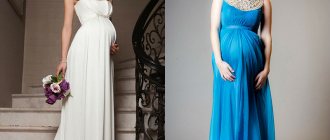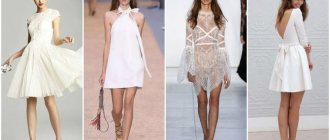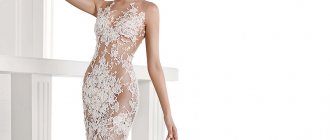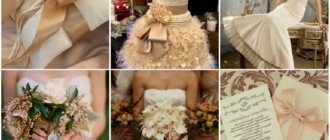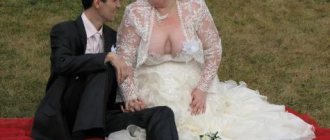Eastern girls observe ancient wedding traditions and customs, which is why they usually approach the choice of a wedding dress with special care and trepidation. Especially when it comes to Muslim women from Pakistan, Turkey, Jordan, Palestine, etc. Oriental wedding dresses emphasize the beauty and femininity of the bride, however, not due to open areas of the body, but due to rich fabrics and unique decor.
Modern designers strive to create luxurious dress models that combine traditionality and modernity, but the image of the bride always remains modest and mysterious. On the website for young people Svadbaholik.ru you will find out what models of dresses in the oriental style exist and what accessories should be present in the wedding look of an oriental bride.
A little history of the creation of Indian wedding dresses
There is a legend that many years ago, while dreaming of his beloved, a young weaver himself did not notice how he wove a very long and beautiful fabric, from which the national Indian outfit - the sari - appeared. Even in modern times, the production of this masterpiece of weaving art in India is mainly done by men. They are the ones who manage to come up with the most perfect combination of bright colors and beautiful patterns.
Wedding traditions in each of the many regions of India have their own differences in the design and ways of wearing the saree. But one thing remains unchanged: the sari is the most common type of national women's clothing in India. In addition to the sari, there are several other types of wedding dresses in Indian culture - salwar kameez and lehenga or ghagra choli. A more detailed description of Indian wedding dresses can be found below.
Celebration scenario
Usually the toastmaster is responsible for creating the script. This tradition can also be used for a themed wedding. All little details should be discussed in advance, since the oriental celebration completely excludes the possibility of holding vulgar and vulgar competitions.
You can entertain guests with the incendiary game “Turban Dzhigita”, in which guests, using a towel, will try to create a turban on their head. This competition is held against time, and the first participant to complete it receives a small gift.
The “Oriental Song” competition will also suit the theme of the wedding celebration. The toastmaster organizes a small competition, where each guest tries to perform a song better than the other participants. Such a competition will give everyone invited the opportunity to have fun from the heart.
Due to the intensity of the program, it is better to end the evening calmly. Best of all, the crown of the celebration was the last dance of the newlyweds. Many couples turn to choreographers for help to make the production truly luxurious, but if this is not possible, you can choreograph the dance yourself.
Sari – the eternal magic of femininity
A sari is a piece of fabric up to 9 meters long. It must be wrapped in several layers around the waist, and the remaining end is thrown over the chest to the shoulder. Indian girls learn the art of wearing and tying a saree from an early age, since it is quite difficult to do this without unnecessary twisting and folding of the fabric. It is also necessary to wear a blouse (choli) with short sleeves with the sari.
A wedding sari is made from thin lightweight fabrics such as:
- organza;
- natural silk;
- chiffon;
Various national ornaments, images of flowers and animals are used to decorate the sari. The edge of the fabric is decorated with rich embroidery made with gold threads, and beads, precious stones, and seed beads are also used to decorate the dress.
The traditional wedding color in India is red, it is a symbol of love and happiness. And also the presence of golden color is required, which means a rich and prosperous life. Also, when making a wedding dress, it is allowed to use colors such as green, blue, pink. But white and black colors have always been forbidden to be used in the manufacture of festive dresses; in India they are a symbol of mourning and grief.
How to make the right choice?
When choosing a dress for nikah, the bride should be guided by Muslim traditions, her own taste and fashion. In wedding clothing you need to consider:
- convenience, both in the physical and psychological sense;
- colors and shades that are in harmony with each other;
- size.
Style
The bride chooses the style of the dress based on her own preferences and guided by certain rules and prohibitions. Since Islam prohibits women from showing off their figure, the dress should not be tight or have transparent inserts. Mermaid styles or corset dresses are not acceptable at nikah ceremonies. Overly lush “princess” dresses will also be inappropriate.
The most popular and appropriate wedding dresses: slightly fitted or A-line
Such styles are feminine and elegant and do not focus on a woman’s shape.
Also, dresses should be long to cover the bride’s legs from the view of others, with long sleeves and virtually no neckline or completely covering the neck. Sometimes the dress is complemented by sleeves or gloves, which completely hides the bride’s hands.
Color
The color of the wedding dress should also emphasize the chastity and tenderness of the girl. Therefore, all light, unobtrusive, pastel and powdery shades are welcome:
snow-white classic;
- beige;
- blue;
- peach;
- pale green;
- light brown;
- pink women's dresses;
- soft lilac;
- mint.
It is unacceptable to choose shades that provoke and attract the attention of men. Bright, provocative and acidic colors are considered prohibited and inappropriate shades:
- red;
- black;
- burgundy;
- grey;
- all dark colors.
It should be taken into account that in lighter shades, embroidery and decor look more organic and feminine.
Material
A bride who chooses the simplest dress style can compensate for this with unusual and complex fabrics. To prevent clothing from being transparent, choose dense materials:
- atlas;
- silk;
- jacquard;
- satin;
- taffeta;
- chiffon;
- chintz;
- guipure.
If the nikah takes place in the summer, chintz dresses will be an excellent option for a girl. This material allows the skin to breathe, it is lightweight and drapes well. The downside is that the fabric wrinkles a lot.
Light flowing dresses are made from chiffon. But due to its transparency, it can only be used in several layers and with a thin lining fabric. Chiffon dresses are distinguished by femininity and tenderness.
Guipure, like chiffon, must have an opaque base.
Satin is almost always used by fashion designers when sewing dresses for nikah. This material is easy to sew, pliable, drapes beautifully and looks very elegant and rich. The flowing effect achieved by draping creates a natural play of shades and draws the eye to the beauty of the bride.
Silk is more finicky than satin when sewing and wearing. But dresses made from it look luxurious and noble.
Also, many girls prefer synthetic materials because of their low price. Such fabrics practically do not wrinkle, some are visually similar to natural ones. But artificial fabrics do not allow the skin to breathe and are highly electrified.
Decor
To dilute the strict style of the dress, brides decorate it with all kinds of stones, embroidery, beads and lace. The belt of the dress can be decorated with beads and sequins, and the hem and sleeves with lace.
Alternative to a dress
The laws of Islam in the 21st century allow brides, instead of a dress, to wear a tunic with trousers or a suit consisting of a floor-length skirt and blouse that covers the girl’s arms, neck and shoulders.
Such suits are often made of the same material. The colors of the top and bottom should look harmonious with each other or be the same shade.
The requirements for suits are exactly the same as for bridesmaid dresses: restraint and modesty.
Salwar kameez
Wedding attire in the Indian style, salwar kameez, consists of narrow or, on the contrary, loose pants, a dress in the form of a tunic and a dupatta. The dress has a length slightly below the hips and slits on the sides. A dupatta is a transparent, lightweight cape. The bride in this wedding dress will feel very comfortable and free. The indispensable attributes of festive attire are, of course, rich decorations in the form of gold embroidery and jewelry.
What's different?
Even among themselves, as you can see, they differ:
- some are more luxurious, demonstrating wealth (Indian, Arabic);
- others, on the contrary, are modest and simple, without unnecessary decor (Japanese, Chinese).
By the way, you can choose this option when you put on a classic silhouette in the morning (you take pictures in it, register in it), and in the evening you select a national one, to maintain the atmosphere of the holiday itself.
As I understand it, if you choose an Indian style, then the wedding, accordingly, is planned in this style.
Lehenga Choli
A lehenga is a long flowing skirt that starts from the hips, while a choli is a short blouse. An indispensable detail of this wedding dress is the dupatta. Mostly wedding attire is made of brocade, silk, organza, and chiffon. Precious stones, hand embroidery with gold threads, glass beads, and rhinestones are used as decoration.
Shade combinations
The powder color range is very rich and includes a large number of colors, including: warm white, cream, nude, soft pink, light peach and many others. Many popular flowers have similar shades, so a powdery wedding bouquet can be very diverse. Depending on the personal preferences of the newlyweds, the composition may include:
- peony and bush roses;
- peonies;
- dahlias;
- carnations;
- asters;
- chrysanthemums;
- lilies;
- orchids;
- eustoma;
- freesia.
The list of colors can be continued endlessly; only the most common types are indicated in the list.
Bridal bouquets in powdery tones can be made entirely from flowers of the same type and variety, or from different flowers. Regardless of the chosen composition, the bouquet will turn out very impressive and original.
A good choice for a mono-bouquet of warm pastel flowers would be roses, peonies, lilies, asters or orchids. Harmonious combinations will create:
- roses and peonies;
- chrysanthemums and asters;
- carnations, asters and dahlias;
- roses, eustomas and carnations;
- roses, orchids and freesias.
From the huge variety of beautiful flowering plants and their possible compositions, it is sometimes very difficult to choose a specific option.
In this case, it is worth turning to the symbolism of flowers in wedding bouquets; perhaps this will play a decisive role and help the bride make up her mind. Roses in the bride's bouquet symbolize passion and love, peonies - good luck and a happy marriage, dahlias - long relationships, carnations - tender and pure love, orchids - beauty and fertility, lilies - prosperity and wealth.
Modern trends in Indian wedding style
Indian style has become very popular in other countries; girls are attracted by the beauty and convenience of a wedding dress. Bright colors, richness and luxury of decor, national flavor - all this is a distinctive feature of this oriental style. Modern trends have also influenced the image of the Indian bride.
When holding a modern wedding in Indian style, the bride does not have to strictly adhere to national traditions; it is enough to add a touch of national flavor to the style or decor of the dress model in the form of national ornaments or patterns.
Variety in palette
By choosing this style, you can choose either a bright or completely white robe, which will also be relevant and quite appropriate. Play with accessories, focus on national details. Don't be afraid to use bright colors.
Here, preference is given to natural fabrics (silk, chiffon, muslin), because the styles should be light and with multi-layer draperies. Models with trains of different lengths or with wide belts that accentuate the waistline will only emphasize the tenderness and grace of the bride.
I advise you to be very careful when choosing jewelry, as they play an important role in the image. Their abundance is welcomed in the style. Therefore, try to choose appropriate jewelry in an elegant frame.
Intricate embroidery, colorful ornaments, and color combinations dramatically distinguish the East from other modern trends.
Indian wedding dresses
The mysterious culture of India attracts people from all over the world - even in the age of globalization, this country has managed to preserve its identity and traditional heritage. It is interesting that many Indians, even in large modern cities, prefer the national costume to ordinary clothes - a women's sari and a men's shevrani. If a couple in love is interested in the culture of this country, a great idea would be to organize a wedding in an oriental style, using traditional Indian attire. Below we will talk in detail about the sari and other women's accessories that a bride can wear to an Indian celebration.
“Highlight” of the East: the main features of a Muslim wedding
Islam is practiced in a significant part of the East, so we will pay attention to such celebrations. We will not bore you with long historical stories, but will simply describe the most important and interesting features of an oriental wedding, and also add some photos:
- People of other religions are not allowed to attend the celebration. And in general, at a Muslim wedding, unlike other peoples of the world, the priority is the official part of the wedding and the observance of religious rules, rather than the banquet.
- Henna night is the night before the wedding. The girls draw mihendi on the young man's hands, arms and legs. And this is done by a woman who is happily married and is an exemplary wife. The longer the henna stays on the bride's hands, the longer she may not do housework.
- An Eastern marriage is considered legal only after the Nikah ceremony, even if you registered it in the registry office. Nikah can be held before or after the official painting. This takes place in a mosque, and the ceremony is performed by a mullah. After which the young people are given a certificate.
- A banquet in the East is a “Valim” ritual, at which alcoholic and even low-alcohol drinks are prohibited. The young family treats guests to sweets and fruits and entertains them with national dances and songs.
Traditional Indian dress for wedding
The women's sari is more than five thousand years old - many legends are associated with it, one of which tells about the creation of the outfit. A long time ago, a young weaver, dreaming about his beloved, did not notice how he sewed a long, very long cloth of unprecedented beauty. It looked so gorgeous that everyone loved it, and over time, the colorful material became the national Indian women's costume. Even now, only men who belong to a special caste of weavers are engaged in making sari - they come up with color combinations and decoration of such a robe.
India includes many regions, each with its own cultural traditions, so the way of wearing and tying a saree differs depending on the territorial customs. The classic version - nivi - remains the most common: according to it, the fabric is wrapped several times around the waist, and then thrown over the shoulder. It may seem that this is easy to do, but in fact, only with experience does an Indian girl learn to do this quickly and easily - it is important that the fabric does not twist, the sari should lie flat and neat.
No pins or buttons are used to secure an Indian sari, although an inexperienced bride trying on an original wedding dress for the first time can neglect this rule and secure the dress using special devices. Under the national costume, modern Indian girls wear a jacket (choli) and a petticoat, which was a consequence of the intervention of European colonialists: they were shocked that Indian women walked half naked. In areas far from cities, some women refuse to wear choli.
As a rule, weavers make Indian wedding saris from organza, silk, chiffon, Mysore silk, which only the wealthiest segments of the population can afford. The edges of the long canvas are embroidered with a rich pattern - flowers, fish, fruits, national ornaments. To embroider a wedding sari, weavers use gold threads; the more elaborate the pattern, the happier and more harmonious the life of the newly-made wife is believed to be. To decorate an outfit accordingly, men use beads, beads, precious or semi-precious stones.
The traditional color of a wedding sari is red, because it means joy and love between lovers. The second main color of this clothing is gold, symbolizing well-being, prosperity, and wealth of a young family. Indian women pay increased attention to the meaning of color, and although it is now possible to wear a sari of any shade to a wedding in India, girls mostly choose red or green, which promise them marital happiness.
The most beautiful images
People who have a vague understanding of Muslim fashion may find it boring and monotonous. However, the images presented below will forever dispel this myth and reveal the true beauty and languor of the East.
For girls
A beautiful dress in a soft blue shade, with a defined waist and flared downwards, will become part of a fashionable look for the celebration of a young Muslim woman. The tenderness and modesty of the color harmoniously combines with the embroidery on the bodice of the dress. A hijab to match the dress is a stylish finish to the look.
Another formal dress is the yellow abaya with peplum. Yes, this dress will not be an acceptable option for countries with strict principles and customs, but it still has a place in the lives of girls living in Europe. The model's open collar can be covered with a golf shirt worn under the dress.
A casual dress a la polo shirt embodies the fashion trend for two-tone models. Buttons and a turn-down collar are an appropriate option for young and stylish people.
For women
Muslim women of advanced age are guided by the tranquility of colors and minimalism when choosing an outfit. However, this does not affect the beautiful image that embodies modesty and religiosity.
A straight beige dress with patch pockets emphasizes the calm and wisdom of a woman. By adding an orange scarf to your dress, you can add a bright detail to your balanced look.
A luxurious dress with a high neck is a good solution for a special occasion. A straight silhouette, puffed sleeves and a necklace to complete the look are everything a woman needs to look irresistible.
The fashion of the East is worthy of admiration. It skillfully combines modesty, femininity and seductiveness of a woman. Muslim dresses are becoming a trend, and designers around the world are bringing these extraordinary patterns and styles into their collections.
Models of modern Indian wedding dresses
Western influence has made some adjustments to the wedding look of Indian women: some girls, instead of the classic red or green sari, decorated with a wide embroidered border, wear clothes of a different shade or models close to popular European styles. Despite these changes, Indian newlyweds manage to preserve the unique features inherent exclusively to their culture, and therefore even the usual classic dresses made by brides from India acquire unusual shapes, original shapes, and original decor with beautiful embroidered designs.
Short sleeve mermaid silhouette
Not only Indian, but also European designers noticed the huge potential of the national women's costume - the sari looks rich, elaborate, and can decorate a girl at any large-scale celebration. Perhaps this is precisely what led to experiments with the shape of this outfit: as wedding decoration, girls began to wear Indian attire made in the style of a mermaid dress. A tight-fitting model, flared from the knees or below, looks great, emphasizes the ideal figure of the bride, and the incredibly beautiful decor of the outfit makes it solemn and majestic.
Current colors and prints
If the style of a Muslim dress can be called modest, then oriental beauties do not limit themselves when it comes to flowers. It is the rich shades of colors that allow Muslim women not to get lost in the crowd, to be feminine and attractive.
The history of Muslim dress indicates that initially all models were black. What prevented Muslim women from dressing brightly? Numerous wars and the gathering of unworthy men on the streets obliged a woman to dress in black and become invisible in the dark alleys of dangerous streets. Men, on the other hand, dressed in white and courageously protected their women. In most countries, the time of war is a thing of the past, but the fashion for black casual dresses remains, although now they can hardly be called faceless.
In addition to the black color present in everyday clothes, in the new collections you can see stylish denim dresses, shades of muted pink and quiet burgundy. Light shades are also chosen as the color scheme for dresses.
Formal models allow a woman to reflect her character, charisma and extraordinary beauty in color. Calmness and harmony of soul can be observed in the girls dressed in elegant dresses of heavenly and emerald shades. Plum and dark blue colors distinguish bright natures, and a soft pink hue speaks of the girl’s youth.
You won’t see trendy youth prints on Muslim dresses, but Eastern fashion has not lost anything from this. Designers develop dresses with classic patterns and patterns that have stood the test of time and fashion. Muslim models are decorated with graceful curves of flowers, fancy semicircular patterns, and abstractions. On youth models you can also see inscriptions in English, however, they have a deep meaning, they talk about God and the world.
Indian style jewelry and accessories
No Indian girl gets married without an abundance of colorful accessories. Researchers attribute Indian women's love for jewelry to the fact that earlier, when wives were highly dependent on their husbands, the latter had the right to kick the woman out of the house at any time. The only things that the girl could take were those that were already on her. Nowadays this phenomenon is not observed, but Indian women still wear a lot of accessories. There is another explanation for this phenomenon: according to ancient beliefs, the more jewelry a bride and groom wears, the happier her life with her husband will be.
Indian women use large ear and nose earrings, bracelets, and necklaces generously decorated with stones as wedding decorations. It cannot be done without the traditional bindi - a dot decorating the forehead of the hero of the occasion. According to an ancient custom, the newlywed's arms, shoulders, back, and legs are painted with henna - this beautiful pattern is called mehendi, each type of it has a specific meaning.
Maha Abdul Rashid
Another fashion business owner and real Dubai it-girl is Maha Abdul Rashid. Thanks to her efforts, the Bambah boutique is very popular in the Arab world. The businesswoman herself has a weakness for vintage things and a distinctly feminine style. Most often, Makha can be seen in a dress with a flared skirt, a colorful sundress with ruffles, exaggerated bows, tops with an open back, high-waisted trousers and guipure blouses. A minimum of makeup and a slightly careless hairstyle with disheveled curls - this is how the oriental fashionista is used to looking! “I believe that a girl looks fashionable when she feels comfortable and confident in what she is wearing,” Maha is sure.
With Leandra Medine
Photos of Indian wedding dresses
There are a great variety of wedding saris; each dress has an individual pattern that has a special symbolism. Regardless of the family’s wealth, for the celebration the bride’s relatives try to get her the best outfit and the most expensive jewelry, which, according to legend, will ward off evil spirits and protect the marriage of the newly-made spouses. To choose a dress for an event in an oriental style, the newlywed needs to explore many options for traditional Indian saris and their varieties. See a selection of photos with Indian wedding dresses:
Important decision
Therefore, before you start choosing a dress, decide for yourself what kind of registration you want:
- Completely oriental themed. With its flavor, when all the canons and traditions are followed, and the appropriate, national onion is chosen
- Or without strict rules - you will support the theme with the help of details: decor, accessories and jewelry. In this case, the outfit can be white and of almost any texture
Let's talk a little about wedding dresses, both in folk images and about models with a European frame. Modernized, but preserving oriental motifs in decorative elements.
Oriental, Chinese, Indian wedding dresses - bright outfits for brides
Modern brides are the heroines of weddings taking place in the most seemingly unexpected styles. One of the most popular today is the oriental style, which requires an outfit created in Indian, Chinese or oriental traditions to maintain.
Themed weddings are colorful celebrations, rich in color and many different nuances that highlight the features of the chosen style. One of the most important heroes of such a celebration is the bride. Indian wedding dresses help create her image and make the holiday even more colorful and rich.
Outfits
Despite the fact that the basis of an oriental wedding will be set by the surrounding decoration, the newlyweds will have to spend most of their time selecting suitable costumes. To fully match the chosen style, it is advisable to find traditional outfits, but this is not always possible. The second possible option is to order the tailoring of the necessary items from a private master, describing to him the desired cut and style of a dress or suit. If this option does not seem the best, you can decorate ordinary wedding dresses yourself, making them look like oriental ones.
A bride at an oriental wedding should be the embodiment of luxury, modesty, beauty and grace. The dress should have a closed back and shoulders, ideally it should have long sleeves down to the wrists, and the neckline should not be emphasized.
The shades can be anything, from classic snow-white to all the colors of the rainbow; it is not recommended to use only black outfits. A burgundy, blue or green dress will look good on dark-haired girls. All outfits should have one thing in common - decoration with patterned embroidery and stones stylized as precious ones.
The bride's hairstyle should be simple but elegant. It is not recommended to leave your hair down; it is better to style it in a cute, relaxed composition. Oriental style allows for both large curls and straight hair. Instead of a veil, it is better to use a thin headscarf made of flowing fabric. You can decorate your hair with tika (lalatika) - a traditional attribute for the head in the form of several strands of precious stones or pearls, converging on the forehead in the form of a large decorative element.
Makeup should complement the image of the bride, for this you need to place the main emphasis on the eyes. In most cases, it is enough to highlight them with black arrows, but sometimes it is necessary to apply bright shadows to match the color of the wedding dress. It is better to make your lips a natural shade; for this you will need a matte lipstick. The manicure should be simple, a classic French style will do. Shoes should be chosen with low heels or flat soles.
Some girls decide to take a bold step - wear nat. This is Indian jewelry in the form of a chain that goes from the ear to the nose. Another distinctive feature of oriental brides is body painting with henna. Black patterns with many small elements are drawn on the girl’s arms and legs. This kind of temporary tattoo makes the image mysterious and attractive.
It is advisable to make the bride’s bouquet from one type of flower, supplementing it with several ornamental plants. Roses, peonies, orchids, lilies or callas are well suited for this. The shade is selected depending on the color of the dress - they should contrast with each other. Flower stems can be wrapped in satin ribbon and decorated with a large brooch.
The image of the groom should also not be ignored, but the suit should be selected after the bride has bought her wedding dress. If it is of a simple cut, with self-made decor, then the groom can wear a regular classic suit, complementing it with a themed boutonniere made of the same flower as his beloved’s bouquet.
If the bride has chosen a truly oriental outfit, then the man must match her. The basis of his image should be trousers, a loose shirt in a neutral shade, a robe with a belt and a turban. All this should be richly embroidered with golden threads and “precious” stones. The groom can wear mojari on his feet - stylized shoes with upturned toes.
Guests at the wedding should also be dressed in oriental style, but their outfits should not overshadow the bride and groom. Girls can choose dresses of a simple cut with a minimal amount of embroidery. The preferred shades will depend on what dress the hero of the occasion will wear. Men can wear trousers, shirts and robes, but less luxurious than those of the groom.
How to choose Indian style dresses for a wedding – ideas
The traditional wedding dress of an Indian bride is a bright sari embroidered with gold. The color of this dress can be:
Sari is a special outfit. It is distinguished not only by its cut and finishing. From ancient times to this day, only men have been making such dresses. The age of the sari exceeds 5,000 years, during which time the outfit has enjoyed constant success in demand and popularity among women all over the world.
A wedding sari is chosen in strict accordance with established rules. For it, only the lightest fabrics are used, bright colors are selected, and no buttons, pins or other fasteners are used. Indian brides have a lot of experience in putting on a saree; other girls just think it is so easy. A wedding dress involves wearing an additional blouse called a choli. It is a kind of short sleeve top not used in daily life.
When creating a wedding sari, weavers select the most complex and elaborate embroidery patterns, which are made with gold threads.
As the saying goes, the more complex the pattern on the canvas, the happier the life of the newlyweds will be after the wedding. The material for this outfit is also special:
- chiffon;
- organza;
- the lightest Mysore silk.
Styles and models
Islamic outfits are not at all boring and monotonous, as many might mistakenly think. They come in several styles for different occasions.
Elegant
Elegant evening dresses for Muslim women amaze with their variety and originality.
Let's look at some of the most attractive models:
- A long floor-length dress, decorated with openwork lace and a thin belt, loosely cinched at the waist.
- Silk abaya with long sleeves, gathered in the form of lanterns at the top. It has no cutout, its collar completely covers the lower part of the neck, shoulders and chest.
- The peplum outfit also deserves special attention. The upper part is lace. Under the openwork lace there is a dense natural fabric. The peplum is made of similar fabric. Its cut is asymmetrical - short in the front and down to the middle of the knees in the back.
Homemade
According to the strict rules of the Muslim world, only in her own home can a woman look seductive and luxurious. The husband is the only person who is allowed to contemplate the open arms and seductive cleavage of his wife. If you are going to welcome male guests at home, a woman must wear closed clothes and a scarf on her head.
The most popular dress for home is called Jalabiya. Its style is somewhat reminiscent of a Japanese kimono. Jalabiya is characterized by:
- V-neck;
- loose batwing sleeve;
- beautiful embroidery along the waistline.
There are other styles of homemade Islamic clothing for women.
An attractive and at the same time practical option is a two-piece outfit, which consists of:
- floor-length underdress, with short sleeves and a small cutout in the neckline;
- an upper cape that can be put on at any time if necessary.
Especially for home prayer, Islamic women wear it from a distance. This modest model in dark colors with a scarf sewn to the collar is worn over a jlabiya.
Casual
Dresses for everyday wear are characterized by a simple and loose cut. There are no fancy patterns or embroidery on such clothes. There are several styles of everyday Islamic attire.
Young women prefer to wear a long dress that resembles a sweatshirt. It is sewn from combined fabrics. The material from which the sleeves, wide collar and hood are made differ from the main material of the product.
The basic element of clothing, which is suitable for Muslim women of any age, is an abaya with a yoke with long sleeves, slightly flared at the bottom. Young fashionistas prefer to combine this outfit with blazers, jackets and thin straps. Mature women, as a rule, wear it without additional accessories.
The most popular models of everyday Muslim women's dresses are complemented by a collar of the same cut as a polo shirt.
Wedding
A separate category consists of dresses for nikah - in other words, wedding dresses. Thanks to the harmonious combination of sparkling rhinestones, beads and sequins, they turn out to be very festive and luxurious. The main emphasis in such dresses is on the piety of the newlywed, so even the slightest hint of vulgarity is unacceptable.
Traditional wedding dresses for Muslim women cover their figure as much as possible.
They are characterized by:
- long sleeves;
- maxi skirt;
- moderately loose fit;
- high collar;
- hijab, which can be complemented with a veil.
Opaque fabrics are used to sew Islamic wedding dresses. The only exception is the veil, which may resemble a familiar European accessory.
Modern wedding dresses for Muslim women are available in several styles. Laconic and sophisticated A-line dresses highlight the charm of oriental brides
They emphasize the slimness of the figure, but do not focus undue attention on female forms. Gold or silver embroidery is most often used as decoration, in harmony with a snow-white dress.
Lush closed dresses with multi-layered skirts made of delicate translucent chiffon are no less impressive. Such outfits are decorated with embroidery, rhinestones or beads.
Oriental style wedding dress – review
Along with the well-known wedding dresses of European masters, oriental-style outfits remain attractive and even a little mysterious. They seem to attract brides from different countries, enchanting with their beauty and chic.
Despite the fact that in such dresses there are no bare shoulders, the hair of the young beauty is always hidden, and often her face, the image of a Muslim bride can be compared to the image of a fairy-tale princess. Arabic wedding dresses are among the richest and most complex. To create such an outfit you need a huge amount of:
- precious and semi-precious stones;
- natural pearls (in rare cases, artificial pearls are used);
- beads;
- embroidery done on very expensive fabric.
The peculiarity of the costume is a large amount of fabric, both light, almost weightless, and satin or silk. The hair, neck, and hands of a young girl must be hidden from prying eyes.
The color of the dress is not always white (a symbol of innocence and purity among European peoples). An oriental wedding suit is sewn using fabric that symbolizes wealth, happiness, health, and longevity.
That is why wedding dresses in oriental style can be:
Expensive jewelry is considered a mandatory accessory. These are not only earrings and rings, this is a belt, a tiara - a kind of crown on the beauty’s head. Embroidery on a wedding dress in oriental style is a national ornament, complemented by rhinestones, glass beads, and, if possible, natural precious stones. The style is chosen in such a way as to emphasize all the advantages of the bride’s figure: her proud posture, thin waist.
Despite the fact that the traditional Arabic wedding dress resembles a robe, it is decorated in such a way that there is no shadow of doubt about the solemnity of the moment for which it was created and put on the girl.
Makeup and hairstyle
Oriental wedding makeup does not imply a natural effect. Eastern women love to focus on their eyes. Arabic wedding makeup is distinguished by graphic arrows and false eyelashes. The best option is smoky eyes. It can be done in non-traditional shades - green, bronze or pink.
Asians even out their complexion by whitening their skin. In this case, a simultaneous emphasis on the eyes and lips is desirable. The eyes are highlighted with a dark pencil, and the lips are decorated with red lipstick in the shape of a bow.
Indian wedding makeup is suitable for dark-skinned girls with dark hair. It uses bronze, green and gray tones. Eyebrows should be neat. The main emphasis is on the bride's look. An integral attribute of Indian makeup is considered to be the bindi - a red dot located in the middle of the forehead.
Eastern brides prefer tied hair. They are pinned into buns or formed into high ponytails. It is advisable to cover your head with a veil or hijab. The use of decorative hairpins and decorations made from fresh flowers is allowed.
The bride's oriental wedding dress allows her to create a colorful, feminine image. The selection of decorations and additional attributes is of no small importance. If every detail is taken into account, the bride will be able to feel like a real heroine of an oriental fairy tale.
Bridal look for a wedding in powder color
Powdery is great for a wedding dress. It personifies tenderness, romance, sensuality. However, this particular shade requires close attention to the bride’s skin color, as it can very easily mute and blend in with the makeup. However, several fittings solve this problem.
Absolutely any style of outfit can be chosen: either lush multi-layered or sensual lace. A light cocktail dress would be just right for a summer wedding.
This color allows you to choose beautiful monochromatic accessories: a necklace, tiara, large comb, earrings, pendant and shoes. Pearl jewelry will look especially good: multi-layer bracelets, stud earrings and pearl strands around the neck.
When the bride's choice is still in favor of a classic white dress, powder color should be used in the bridesmaids' dresses. This will emphasize the atmosphere and style of the event.
It is better to make the bouquet non-contrasting, in different delicate shades of rose and beige. For brightness, you can add snow-white flowers or greenery. Decorate the flower arrangement with satin ribbon, lace or a string of mother-of-pearl beads.

